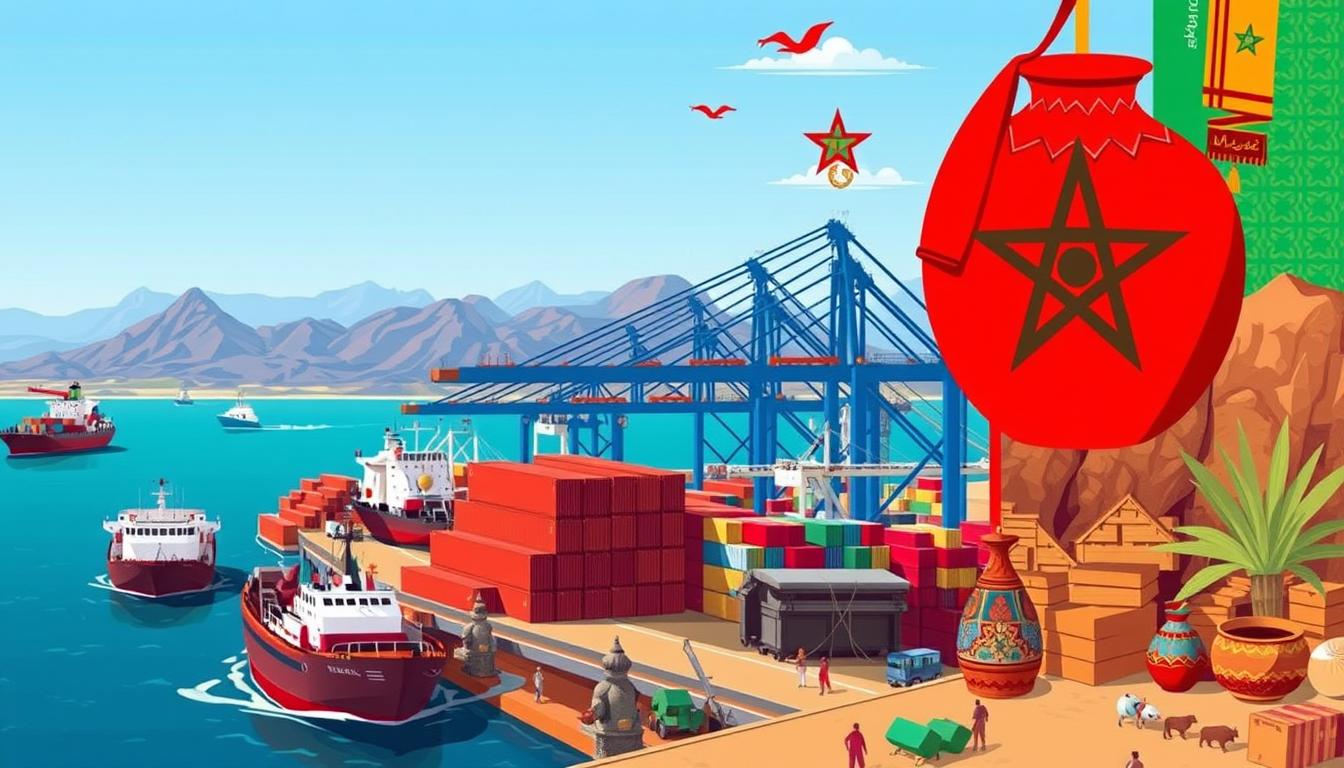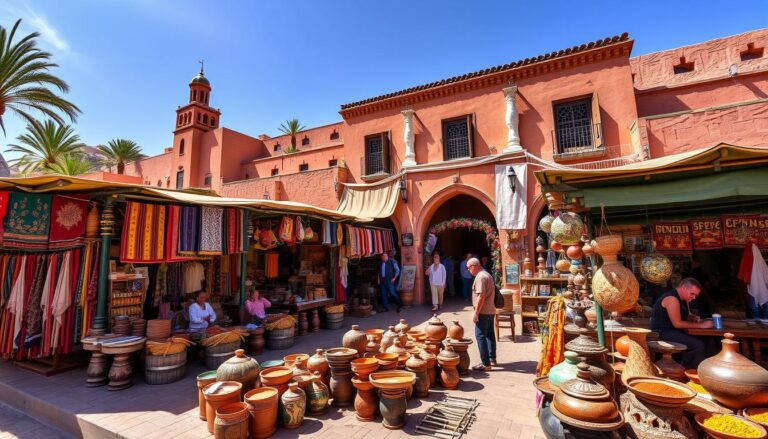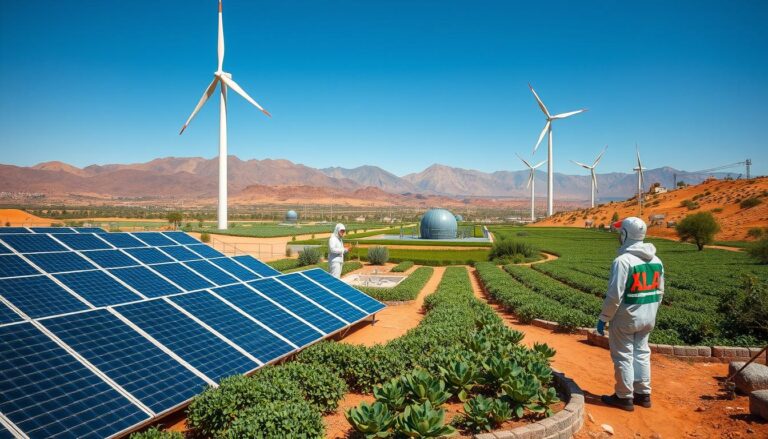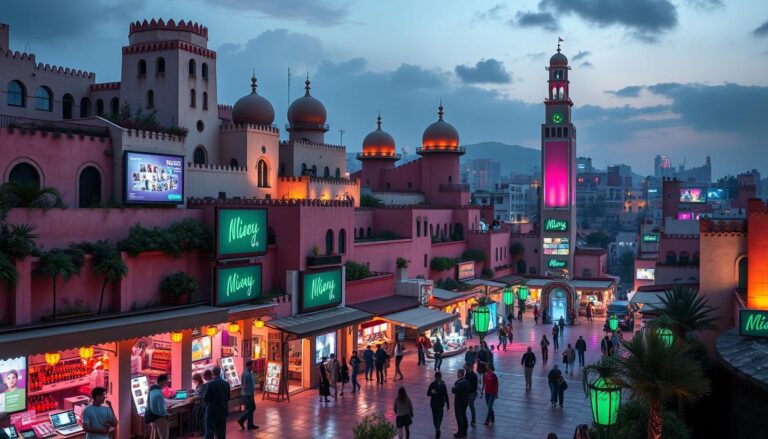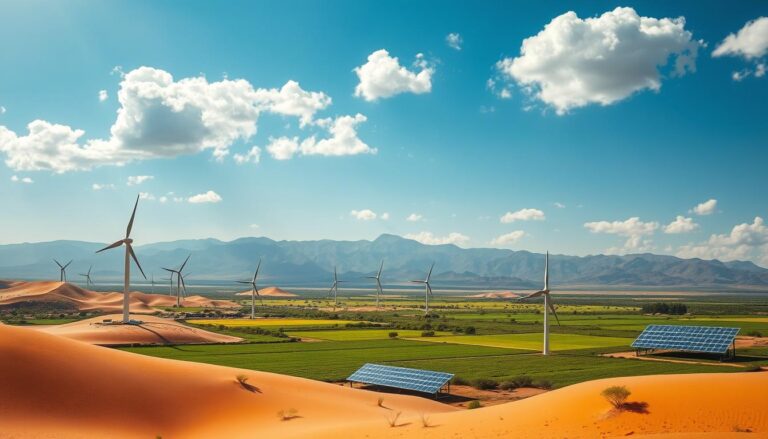Imagine a nation’s export strategy changing its economy and cutting poverty. Morocco is living this dream. The Made in Morocco Export Strategy has been key in changing the country’s economy. Since 1992, the country’s income per person has tripled, thanks to smart export plans and better infrastructure.
Morocco, with 37 million people, has made its economy open. This has brought more choices for consumers and involvement in global tech chains. In 2021, Morocco’s exports hit $27.5 billion, and foreign investment reached $2.3 billion. The IMF says Morocco’s economy will grow by 3.5% in 2023 and 4.5% in 2024. But, to match European living standards, more work is needed.
Experts from the Policy Center for the New South and the World Bank say targeted reforms are essential. These reforms will make Moroccan firms more competitive in exports and imports. Also, growing the service sector is key for jobs and lasting growth.
Modern infrastructure and logistics have been crucial for Morocco’s success. But, better trade policies and rules, like Law No. 42-18 and Decree No. 2-21-346, are vital for the export industry. International partnerships, like with the EU, also help Morocco in the global market.
Let’s explore more about Morocco’s changing export scene and its bright future.
Introduction to Moroccan Exports
For over three decades, Morocco has shown a strong commitment to trade and industry. This has greatly shaped its economy. The focus on Moroccan products has helped reduce poverty and boost economic growth.
The Evolution of Moroccan Export Policies
Morocco’s export rules have changed to make the market more open and competitive. Young firms, especially, have done well, often starting to export right after they begin. Key areas like garment, textile, and leather have grown a lot, with most products being exported within a year.
The government has worked hard to make manufacturing firms more productive. This effort has led to more Moroccan products being sold worldwide. It shows Morocco’s export policies are dynamic and support the country’s growing exports.
Impact on Economic Growth and Poverty Reduction
The focus on exports has greatly helped Morocco’s economy and reduced poverty. The Royal Commission aims to improve trade to raise living standards to EU levels. Despite challenges like COVID-19 and price changes, Morocco’s export sectors have remained strong.
Export growth has been key to stabilizing Morocco’s economy. The country’s GDP is expected to grow by 4.6% in 2024. This shows a healthy economy. Also, Morocco’s export rules have encouraged new products for foreign markets, leading to more economic growth and lower poverty.
Key Sectors in Morocco’s Export Market
Morocco’s export market is rich and varied. It has several key sectors that drive the economy and create many export chances.
Agricultural Exports: Opportunities and Challenges
Agriculture is a big part of Morocco’s economy. It makes up about 12% to 17% of the GDP and employs 45% of the workforce. The country exports many agricultural products like tomatoes, green beans, and citrus fruits.
These exports are very important for Morocco’s economy. They help keep the country stable financially.
But, the agricultural sector has its challenges. Water scarcity and energy use are big issues. To solve these, Morocco is moving towards renewable energy and water-saving methods.
Investing in these areas could bring new chances for Morocco’s agri-food sector. It could help diversify and add value to exports.
Manufacturing and High-Tech Industries
Morocco’s manufacturing and high-tech sectors are key to its exports. They make up 30% of the GDP. The manufacturing sector focuses on mining, phosphate processing, textiles, and food processing.
The automotive and aerospace sectors show Morocco’s role in global value chains. The country aims to be Africa and the Middle East’s top car producer by 2025.
The aerospace industry also attracts big global players. This boosts Morocco’s export options. These sectors highlight the many export chances in Morocco, thanks to innovation and growth strategies.
The Role of Trade Agreements in Boosting Exports
Morocco has focused on making and growing trade agreements to boost its exports. These agreements are key to its export strategies and shape its economy.
Impact of the US-Morocco Free Trade Agreement
The US-Morocco Free Trade Agreement (USMFTA) was a big step for Morocco in 2006. It’s the only U.S. Free Trade Agreement in Africa. It lets Morocco sell many products to the U.S. without paying duties.
This has helped Morocco grow its exports and sell to more places.
Advantages from EU and African Continental Free Trade Agreements
Morocco also benefits from the EU-Morocco Association Agreement since 2000. It makes tariffs on industrial goods go away over 12 years. It also gives duty-free access for some farm products.
These agreements are crucial for Morocco’s growth. They help increase trade.
Joining the African Continental Free Trade Area (AfCFTA) in 2019 shows Morocco’s dedication to trade. The AfCFTA aims to make one big market for 54 countries. It helps Morocco reach more African markets.
Even so, Moroccan exports could be higher in Africa. This shows the need for stronger trade agreements and strategies.
Morocco’s Infrastructure and Its Role in Exports
Morocco has made big steps in improving its trade infrastructure. This has helped the country’s economy grow and boost its exports.
Modern Port Facilities
The Tanger Med port is a key part of Morocco’s trade infrastructure. After expanding in 2019, it became the biggest container port in the Mediterranean. Now, with Tanger Med II, the port can handle more, making Morocco’s exports better.
Transportation and Logistics
Morocco’s highway network shows the country’s focus on better transport and logistics. It’s growing from 1,800 to 3,000 kilometers by 2030. This will make moving goods easier.
The Casablanca-Rabat high-speed rail line was finished in 2022. It makes traveling faster and helps exports move more smoothly. A new line between Tangier and Casablanca will also make things faster, improving logistics.
Industrial Zones and Free Trade Areas
Morocco is investing in industrial zones and free trade areas to grow exports. Places like the Tanger Med Zones are creating a strong, export-focused industry. They have more industrial and logistics centers.
Foreign direct investments (FDIs) in these zones have gone up a lot. The manufacturing sector’s share rose from 15% to 37% between 2010 and 2019. Using these zones brings in more international money and improves export logistics.
Sustainability in Export Production
Morocco is deeply committed to sustainability in its export production. It focuses on renewable energy and innovative water management. These efforts are key to sustainable export production in Morocco.
Renewable Energy Initiatives
Morocco is investing heavily in renewable energy. The Noor CSP complex is a big step towards using solar power. It aims to make 52 percent of the country’s energy come from renewables by 2030.
This move is good for the environment and makes Moroccan exports more competitive. It ensures a steady, affordable energy supply.
Water Conservation Methods
Morocco is also tackling water scarcity head-on. The National Water Management Plan 2020–2050 is a $40 billion effort. It’s crucial for keeping agriculture and industry sustainable.
Advanced irrigation and desalination projects are leading the way. They support Morocco’s goal of sustainable development.
Strategies for Diversifying Export Destinations
Morocco is working hard to find new places to sell its goods. It wants to sell more to countries it doesn’t usually trade with. This includes reaching out to new markets in the EU and Asia.
Focus on Untapped EU Markets
The EU is a big chance for Morocco. The country aims to sell more to parts of Europe that haven’t bought much from it before. This could lead to a lot of growth.
Right now, Morocco sells about 42 different products for every million people. This is less than Turkey and Malaysia. By selling more, Morocco can be more like countries that do well in manufacturing.
Opportunities in Asian Markets
Asian countries are growing fast and need more goods. Selling more to Asia fits well with Morocco’s plans to balance its trade. Even though high-tech exports have dropped, there’s still a chance to grow in this area.
By using strong trade ties, like those in the African Continental Free Trade Agreement, Morocco can do well. Selling more products can also make the economy more productive. It’s all about growing and finding new markets for sustainable growth.
The Role of Innovation and Human Capital in Export Growth
Morocco has a new plan to boost its economy. It focuses on improving education and innovation to grow exports. The goal is to double the GDP per capita by 2035 and make sure 75% of 15-year-olds can read well.
Investing in Education and Skills
Morocco is putting a lot of money into education and skills. It wants to see 80% of people working in formal jobs and double the number of women in the workforce. This will help create a strong workforce for industries that boost exports.
They also plan to grow the share of high-tech industries to 50% of industrial value. This will help create a skilled workforce and support new industries.
Encouraging Private Sector Innovation
The private sector is key to Morocco’s export growth. Morocco wants private investment to make up two-thirds of all investment by 2035. They’re setting up a new investment fund and updating the investment charter to help.
The automotive industry is growing fast thanks to new technology and innovation. Morocco’s location and modern ports, like Tangier, make it a key hub for exports. This shows how important private sector innovation is.
Improving education and innovation are at the heart of Morocco’s economic plan. They aim to make Morocco a big player in global markets.
Improving Competitiveness of Moroccan Firms
Boosting Moroccan exports is key for lasting economic growth. Morocco needs more than just trade policies to succeed. It must reform its investment climate and protect its currency from market changes. This will help the export industry grow and support sustainable development.
Morocco’s economy has shown strong growth, with incomes tripling since 1992 and poverty dropping by threefold in 30 years. Yet, living standards are still lower than in the European Union. The services sector is crucial, creating 47% of formal jobs and nearly 90% of new ones. To grow the economy, Morocco should diversify exports and add value to its food products.
After the pandemic, Moroccan firms, especially in textiles and clothing, need to get digital. The GTEX/MENATEX project shows how digitalization can improve efficiency and empower women. Simplifying rules and improving infrastructure will also attract big investors, like Yazaki and Lear Corporation. These investments have brought over $10 billion in revenue, making Morocco a leader in car parts and green energy.
More work is needed to tackle regulatory, legal, and labor issues. This ensures everyone benefits from free trade and investment. By focusing on these challenges, Morocco can strengthen its market position and drive economic growth.
Source Links
- Morocco: A Strategic Trade Hub Between Africa and Europe – ET2C International
- Morocco advances establishment of national export control system for dual-use goods
- Morocco – Investment Climate Statement
- Economy of Morocco
- Morocco – Distribution and Sales Channels
- Morocco’s Economy & main industries
- Morocco – Agriculture, Tourism, Manufacturing
- Morocco’s Long Road Toward Economic Transformation
- Morocco: Boosting private-sector competitiveness for export success
- Morocco – Trade Agreements
- Trade Policy in Morocco: Taking Stock and Looking Ahead
- Morocco’s Long Road Toward Economic Transformation
- Sourcing Advantage: Why Morocco is a key player in Africa-Europe Trade – ET2C International
- Morocco’s New Challenges as a Gatekeeper of the World’s Food Supply: The Geopolitics, Economics, and Sustainability of OCP’s Global Fertilizer Exports
- Morocco’s Long Road Toward Economic Transformation
- The U.S.-Morocco FTA After Twenty Years
- No title found
- Overview
- Morocco – United States Department of State
- Morocco: Boosting private-sector competitiveness for export success
- Diversification and growth: How the US-Morocco FTA boosts Rabat’s modern trade
- Morocco: Improving the international competitiveness of the textile and clothing sector (GTEX/MENATEX)

The Editorial Team is a passionate group of Morocco enthusiasts dedicated to sharing the beauty, culture, and wonders of this captivating country. With diverse backgrounds and a deep love for travel, we strive to bring you engaging and informative content that inspires your Moroccan adventures. From uncovering hidden gems and sharing local insights to exploring mouthwatering cuisine and showcasing the vibrant lifestyle, our team is committed to providing you with valuable resources and exciting stories that enhance your exploration of Morocco. Join us on this journey as we celebrate the rich heritage and unforgettable experiences that make Morocco truly special.

